| Author |
Message |
|
Dariusz Dario T. W
Location: obamaland Joined: 17 Feb 2007
Posts: 33
|
 Posted: Wed 23 Jul, 2008 8:53 pm Post subject: conquistador's burgonet Posted: Wed 23 Jul, 2008 8:53 pm Post subject: conquistador's burgonet |
 |
|
Hello friends
I got this question - would 1530s Spanish conquistador -cavalryman - (Peru, Chile, Colombia etc) use fully developed burgonet ?
If so could anyone point to or show any images of such early burgonets helmets in the arsenal of the Spanish conquistadors?
This question was 'born' as I was looking at a reconstruction of one of the Pizarro's men of Cajamarca done for a Polish magazine Rzeczpospolita. This magazine has been printing every Saturday a colorfull booklet addition to the main issue titled "Batalie i wodzowie wszech czasów"(more or less 'battles and commanders of all times' ). IN the last issue the subject was Pizarro - and they show one of the Pizarro's cavalrymen (ilustrator is Marek Szyszko, veteran of historical illustration in Poland) wearing fully developed bourgonet, although without a buffe (lower face and front of a nect protection)
http://www.rp.pl/galeria/85180,1,164545.html (this images and others will be available for download until Friday, I think)
also they show a morion helmet that belongs to 1580s, nice musket of late 16th century or even 17th century etc
I think Spanish - Pizarro's- army in Inca releam circa 1532 would not have such burgonet helmet in their arsenal - rather various armets, sallets - of a Spanish version etc. I think such burgonet as shown belongs to the second half of the 16th century, but then I may be wrong.. 
thanks
"veni, vidi, Deus vincit"
Jan Sobieski, Rex Poloniae et Dux Lithuaniae
http://dariocaballeros.blogspot.com/
|
|
   |
 |
Chad Arnow
myArmoury Team


|
|
    |
 |
Sean Flynt

|
|
   |
 |
Sean Flynt

|
|
   |
 |
|
E.B. Erickson
Industry Professional
|
 Posted: Thu 24 Jul, 2008 2:47 pm Post subject: Posted: Thu 24 Jul, 2008 2:47 pm Post subject: |
 |
|
I think that in Peterson's book on Colonial Arms and Armor, there are some illustrations of Onate's expedition, and they show visored burgonets on the cav, and also on the mounted harquebusiers (sp?). This expedition was after the conquistador period, but not by much. When I get back home in two days, I'll see if I can remember to check what else is in Peterson's book that is pertinent to this thread.
--ElJay
|
|
   |
 |
|
Dariusz Dario T. W
Location: obamaland Joined: 17 Feb 2007
Posts: 33
|
 Posted: Thu 24 Jul, 2008 4:37 pm Post subject: Posted: Thu 24 Jul, 2008 4:37 pm Post subject: |
 |
|
thanks a lot good gents!
I still think, upon reading some more and looking at the pictures in the links provided by all of you, that this particular type of burgonet shown in the illustration is of the later form, not of the 1520-30s.
This particular burgonet show in the Szyszko's illustration appears to belong to 1560s onward - but then it also looks a bit like this German one of 1520-30s
http://www.myArmoury.com/talk/download.php?id=15126
BY the way, I go regularly to the MET where I have seen quite a few burgonets and one day got to show my pictures here 
Nowhere I have said and I still am not saying that the conquistadores did not use burgonets at all - on that great adventure of Inca realm conquest - quite contrary, they must have, especially since some of the conquistadors were actual veterans of the Italian wars etc, where they must have found plenty many occassions to see and experience different versions of burgonets and other helmets etc.
I just think that the Pizarro's cavalryman of Cajamarca was somewhat richer and better equiped fighting man than his infantryman, and he used closed helmets etc, because they gave more protection agains projectile weapons (stones, arrows, atlatal javelins etc) of the Incas than open face helmets of then burgonet type.
but then I still may be wrong ...
by the way, Onate expedition was quite a bit after the conquista of Peru (60 years) but it did come at the end of the era of la conquista. But 1590s seem to belong to a different era in weaponry and armour than the Cajamarca masacre.
But then during that expedition to conquer New Mexico, 1590s, we could see all sorts of burgonets, but especially famous morions that came to symbolize a Spanish conquistador ...
"veni, vidi, Deus vincit"
Jan Sobieski, Rex Poloniae et Dux Lithuaniae
http://dariocaballeros.blogspot.com/
|
|
   |
 |
Sean Flynt

|
|
   |
 |
Russ Thomas
Industry Professional

|
 Posted: Sat 26 Jul, 2008 4:09 am Post subject: Posted: Sat 26 Jul, 2008 4:09 am Post subject: |
 |
|
Dariuz,
Certainly burgonets were in use by the 1530's, and the very similar casque or casquetel even earlier. If you are going to the Met. you might have a look at the so called 'Montmorency' armour. It was supposed to have been the armour of Anne de Montmorency, Constable of France, but lately some scholars have for odd reasons ascribed it to King Henry VIII. It has a rather nice early full burgonet and buffe. Admittedly it is a little later, ca. 1542-44, but is shows a fully developed ( Italian ? ), burgonet. Also, though this is hardly the armour of a relatively poor soldier ! , the Negroli brothers made most of their parade armours with burgonets of one form or another.
Certainly it was a period of great change and there are very many possibilities for this period. Sallets were only just going out of fashion, and armets too!
If I recall correctly, the equestrian armour in the Wallace Collection made by Hans Ringler for Otto Heinrich, Count Palatine of the Rhine, has a burgonet and falling buffe, and is I think dated 1532.
Regards,
Russ
Carpe diem, quam minimum credula postero !
http://www.living-history.no
|
|
   |
 |
|
Dariusz Dario T. W
Location: obamaland Joined: 17 Feb 2007
Posts: 33
|
 Posted: Sat 26 Jul, 2008 2:37 pm Post subject: Posted: Sat 26 Jul, 2008 2:37 pm Post subject: |
 |
|
Hello gentlemen,
thanks a lot again, I will look at that 'Montmorency' armor/armour. Will take some pictures and post them here, I hope 
I just wonder how much influence the German armour making at the begining of 16th century had on the Spanish and their armour, especially Spanish in the Americas.
I downloaded from google-books a book titled 'Spanish Arms and Armour', so perhaps I find some answers there
I ordered a set of books on the Wallace collection, so perhaps I will find this Otto Heinrich's armour in there.
by the way anyone knows any well illustrated books on the Styrian/Graz armoury/ collection in Austria
"veni, vidi, Deus vincit"
Jan Sobieski, Rex Poloniae et Dux Lithuaniae
http://dariocaballeros.blogspot.com/
|
|
   |
 |
Chad Arnow
myArmoury Team


|
|
    |
 |
James Arlen Gillaspie
Industry Professional

Location: upstate NY Joined: 10 Nov 2005
Posts: 587
|
 Posted: Sat 26 Jul, 2008 6:32 pm Post subject: Posted: Sat 26 Jul, 2008 6:32 pm Post subject: |
 |
|
Here's the helmet of the famous 'spiked' armour in the Bargello, Firenze, dated 1515. Burgonets of some sort were in use in the 15th century, and there were helmets with the brim that characterizes 'burgonets' as far back as the 14th century, though they don't seem to have been popular. It is interesting that Marek Szyszko has portrayed the Spanish cavalryman as wearing a half armour of 'Maximilian' form, though without flutes; the Spanish didn't quite take to the classic 'Maximilian' style, and when they did put flutes in it, it tended to look more like surviving armours of Charles V from the same period. You will note that Mr. Szszko has put a LOW comb (more of a 'crest' really) on his warrior's helmet, not unlike this other helmet in Philadelphia, a not uncommon helmet.
 Attachment: 54.79 KB Attachment: 54.79 KB
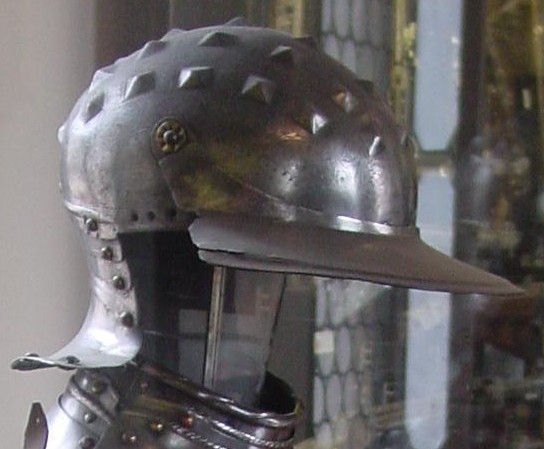
 Attachment: 140.34 KB Attachment: 140.34 KB
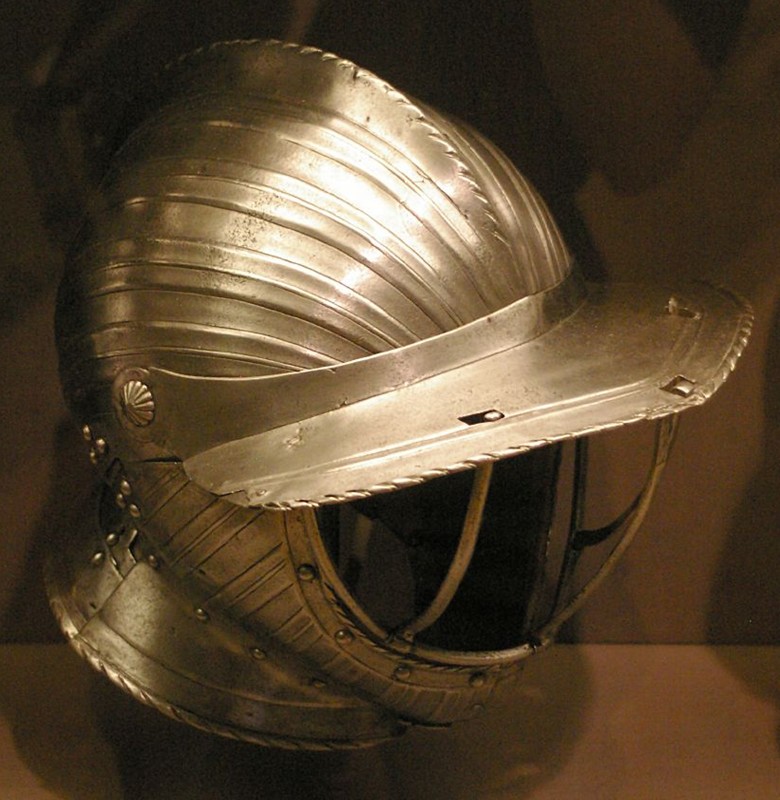
jamesarlen.com
|
|
   |
 |
James Arlen Gillaspie
Industry Professional

Location: upstate NY Joined: 10 Nov 2005
Posts: 587
|
 Posted: Sat 26 Jul, 2008 6:48 pm Post subject: Posted: Sat 26 Jul, 2008 6:48 pm Post subject: |
 |
|
Oh, and here's the armour thought to have been worn by Henry VIII in 1544 at the siege of Boulogne. Claude Blair figured out what it was, and folks at the Royal Armouries and the Met NYC were very happy once they were persuaded (though I'm sure the RA would have been even more joyful if the discovery had been made BEFORE the harness left the U.K.).
 Attachment: 145 KB Attachment: 145 KB
[ Download ]
jamesarlen.com
|
|
   |
 |
Russ Thomas
Industry Professional

|
 Posted: Sun 27 Jul, 2008 12:30 am Post subject: Posted: Sun 27 Jul, 2008 12:30 am Post subject: |
 |
|
There is a casque in the Wallace Collection, A.89. Italian ca. 1510, which is almost identical to the shape of the Bargello example.
James,
I don't want to hijack the thread, but you said that Blair had figured it out ? Does he think that it might have been Henry's ? I find it strange that the harness, which was supposed to have been captured by the first Earl of Pembroke at the Battle of St. Quintin in 1557, and which has been in their possession ever since , is now given a quite different provenance. The only 'evidence' , I know of, supporting the theory of its have been Henry's is the similarity to the entry in the 1547 inventory? I know that Claude Blair and Stuart W. Pyhrr have written an article about it, but my copy got lost in the post and hasn't been replaced yet. 
Apologies for going a bit off topic here!
Dariuz,
Parts of Spain were also part of the empire of Charles V in the early 16th century, so I think that there is a very plausible link between Germany and Spain, and that a great deal of trade passed between the two countries. It was just unfortunate for Charles, that he had France and Francois right in the middle ! A fact that helped lead to war between the two on several occassions.
Regards,
Russ
Carpe diem, quam minimum credula postero !
http://www.living-history.no
|
|
   |
 |
Russ Thomas
Industry Professional

|
 Posted: Sun 27 Jul, 2008 6:06 am Post subject: Posted: Sun 27 Jul, 2008 6:06 am Post subject: |
 |
|
Here is the Wallace Collection casque. A.89, ca. 1510..........
And another view of the 'Montmorency' burgonet and buffe. Image courtesy of THoog.
Regards,
Russ
 Attachment: 97.71 KB Attachment: 97.71 KB
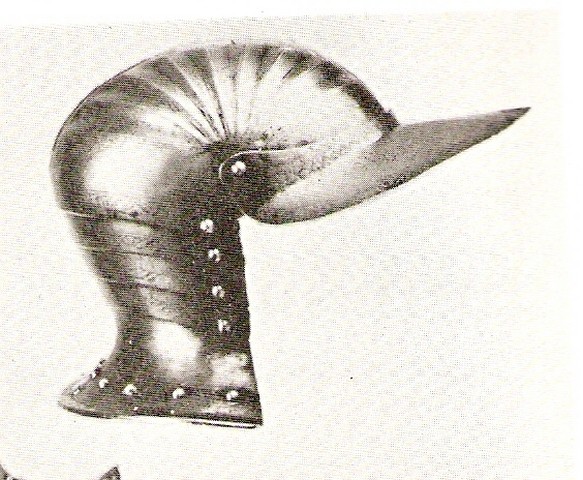
 Attachment: 98.19 KB Attachment: 98.19 KB
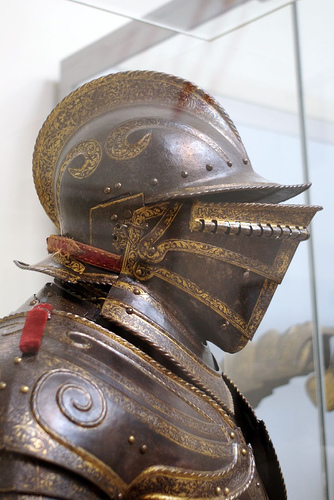
Carpe diem, quam minimum credula postero !
http://www.living-history.no
|
|
   |
 |
Russ Thomas
Industry Professional

|
 Posted: Sun 27 Jul, 2008 7:10 am Post subject: Posted: Sun 27 Jul, 2008 7:10 am Post subject: |
 |
|
Here is another interesting burgonet / casque, from Milan, ca.1530?
Regards,
Russ
 Attachment: 35.14 KB Attachment: 35.14 KB
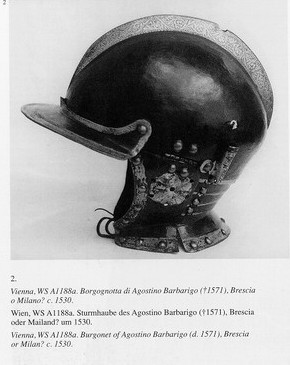
Carpe diem, quam minimum credula postero !
http://www.living-history.no
|
|
   |
 |
|
Dariusz Dario T. W
Location: obamaland Joined: 17 Feb 2007
Posts: 33
|
 Posted: Sun 27 Jul, 2008 8:28 pm Post subject: Posted: Sun 27 Jul, 2008 8:28 pm Post subject: |
 |
|
gentlemen,
nice response, keep on coming, thanks a lot 
| Russ Thomas wrote: | There is a casque
Dariuz,
Parts of Spain were also part of the empire of Charles V in the early 16th century, so I think that there is a very plausible link between Germany and Spain, and that a great deal of trade passed between the two countries. It was just unfortunate for Charles, that he had France and Francois right in the middle ! A fact that helped lead to war between the two on several occassions.
Regards,
Russ |
Actualy it was the whole of Spain - both kingdoms of Castilla and of Aragon were part of Charles I ( he was known also as Charles V of the Holy German Empire) Iberian realm, especially after 1522 -23 or the war of the comunidades (Castilla) and war of germanias (Aragon). He was the first king to unite and rule over both kingdoms, thus 'uniting' Spain.
Spain had her traditional weapons and armour producing center located in Toledo (Castilla), and traditionally Spanish got their armour form Milan.
Most of the conquistadores came from Extremadura,also province of the Kingoom of Castilla, and at Zafra (famous cow town long before the cowboys and vaqueros of the New World) showed their riding skills  , since they were very poor and traditional they used to fight for los reyes, and sometimes against them. They probably used more traditional Spanish arms and amrour, perhaps including some version of burgonet. , since they were very poor and traditional they used to fight for los reyes, and sometimes against them. They probably used more traditional Spanish arms and amrour, perhaps including some version of burgonet.
Conquista chroniclers mention the following metal helmets and their parts:
- 'capacete', 'casco', and 'bacinete', but they also mention face protection 'alconetes', 'antiparras', 'ventanillas', lowe face protection known as 'babera' (also known as baberol, babera, barbote), and left shoulder and lower face protecction known as 'bufa ' (especially Coronado expedition)
Also drawings of Guaman Poma de Ayala (himslef an Inca daughter and conquistador offspring) shed some light on the Pizarro's men equipment.
http://www.kb.dk/permalink/2006/poma/info/es/frontpage.htm
Dario
"veni, vidi, Deus vincit"
Jan Sobieski, Rex Poloniae et Dux Lithuaniae
http://dariocaballeros.blogspot.com/
|
|
   |
 |
|
Dariusz Dario T. W
Location: obamaland Joined: 17 Feb 2007
Posts: 33
|
 Posted: Sun 27 Jul, 2008 8:36 pm Post subject: Posted: Sun 27 Jul, 2008 8:36 pm Post subject: |
 |
|
| James Arlen Gillaspie wrote: | | It is interesting that Marek Szyszko has portrayed the Spanish cavalryman as wearing a half armour of 'Maximilian' form, though without flutes; the Spanish didn't quite take to the classic 'Maximilian' style, and when they did put flutes in it, it tended to look more like surviving armours of Charles V from the same period. You will note that Mr. Szszko has put a LOW comb (more of a 'crest' really) on his warrior's helmet, not unlike this other helmet in Philadelphia, a not uncommon helmet. |
1st helmet -very inteersting helmet indeed
Mr Szyszko has done many fantastic and many not so fantastic reonstructions, I think his artowrk is going to be a subject of Polish Army Museum exhibit later this year or early next year. He was a great comics artist and illustrated many children books - too bad Osprey never hired him to do any work, eg Polish Medieval Armies could have used a better illustration, but then illustrator does what writer provides him with, ergo in this article the same story...
that second helmet from Philadelphia - is that a burgonet?
"veni, vidi, Deus vincit"
Jan Sobieski, Rex Poloniae et Dux Lithuaniae
http://dariocaballeros.blogspot.com/
|
|
   |
 |
Sean Flynt

|
|
   |
 |
Russ Thomas
Industry Professional

|
 Posted: Mon 28 Jul, 2008 8:17 am Post subject: Posted: Mon 28 Jul, 2008 8:17 am Post subject: |
 |
|
Sean,
Is that the Micheal Witt armour in Vienna ??
Dariuz,
Indeed, I stand corrected! I was thinking that it was Phillip II that unified Spain.  
Regards,
Russ
Carpe diem, quam minimum credula postero !
http://www.living-history.no
|
|
   |
 |
Sean Flynt

|
 Posted: Mon 28 Jul, 2008 8:49 am Post subject: Posted: Mon 28 Jul, 2008 8:49 am Post subject: |
 |
|
| Russ Thomas wrote: | Sean,
Is that the Micheal Witt armour in Vienna ??
|
It's from the Spanish Arms and Armor book Dariusz mentioned above. I just had to check that out and found it to be very interesting (and free, of course!). The caption is illegible due to poor scanning, unfortunately. By the way images in the online version are a bit clearer than those in the PDF (or maybe I'm just using an unreasonable magnification when viewing my PDF). It's worth a look, anyway. It's mostly 16th c. pieces from the Spanish Royal Armoury, Madrid.
The book is early 20th c., so there's no telling where all of these pieces are today.
-Sean
Author of the Little Hammer novel
https://www.amazon.com/Little-Hammer-Sean-Flynt/dp/B08XN7HZ82/ref=sr_1_1?dchild=1&keywords=little+hammer+book&qid=1627482034&sr=8-1
|
|
   |
 |
|
|
You cannot post new topics in this forum
You cannot reply to topics in this forum
You cannot edit your posts in this forum
You cannot delete your posts in this forum
You cannot vote in polls in this forum
You cannot attach files in this forum
You can download files in this forum
|
All contents © Copyright 2003-2024 myArmoury.com — All rights reserved
Discussion forums powered by phpBB © The phpBB Group
Switch to the Basic Low-bandwidth Version of the forum
|

